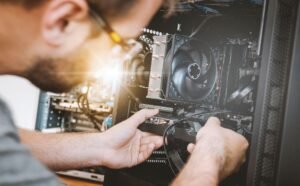Deep Learning Synonyms
Deep learning, a subfield of machine learning, has gained significant attention in recent years due to its ability to learn and make predictions from vast amounts of data. The term “deep learning” is often used interchangeably with other related terms, causing confusion among those interested in understanding the field. In this article, we will explore the different synonyms used for deep learning and clarify their meanings.
Key Takeaways
- Deep learning is a subfield of machine learning that focuses on using neural networks to learn and make predictions from large datasets.
- Artificial Neural Networks (ANNs) and Deep Neural Networks (DNNs) are often used as synonyms for deep learning.
- Deep Learning is different from traditional machine learning algorithms as it can automatically learn features from raw data.
- Common applications of deep learning include image and speech recognition, natural language processing, and autonomous vehicles.
**Artificial Neural Networks (ANNs)**, commonly known as neural networks, are a computational model inspired by the human brain. They consist of interconnected nodes or “neurons” that process and transmit information. ANNs use a layered structure to represent different levels of abstraction in the data, and during the learning process, they adjust the connection strengths between neurons to improve performance. *Using ANNs, deep learning algorithms can learn from the data and make complex predictions or classifications.*
**Deep Neural Networks (DNNs)** are a specific type of artificial neural network that contains multiple hidden layers between the input and output layers. These hidden layers enable DNNs to learn hierarchical representations of the data, hence the term “deep.” *The depth of the network allows DNNs to extract features at different levels of abstraction, making them powerful learning models for complex tasks.*
Table 1: Comparison of Deep Learning Synonyms
| Term | Definition |
|—————-|—————————————————————————————————————|
| Deep Learning | Subfield of machine learning using neural networks to learn and make predictions from large datasets. |
| Artificial Neural Networks (ANNs) | Computational model inspired by the human brain, using interconnected nodes to process and transmit information. |
| Deep Neural Networks (DNNs) | Specific type of artificial neural network with multiple hidden layers for learning hierarchical representations. |
**Machine Learning** is a broader field that encompasses various algorithms and techniques that allow computer systems to learn from data and make predictions or take actions. While deep learning is a subset of machine learning, it differs in the way it learns and represents data. Deep learning models automatically learn features from raw data, eliminating the need for manual feature engineering. *This automated feature learning makes deep learning particularly well-suited for tasks with high-dimensional or unstructured datasets.*
**Neural Networks (NNs)**, in the context of deep learning, are the basic building blocks used to create more complex models. NNs are composed of interconnected nodes, or artificial neurons, that pass signals to each other. *These artificial neurons apply mathematical functions to the input data and transmit the processed information to the next layer of the network.*
Table 2: Comparison of Deep Learning and Machine Learning
| Term | Description |
|——————-|————————————————————————————————————–|
| Deep Learning | Subset of machine learning that learns automatically from raw data, using neural networks. |
| Machine Learning | Discipline that uses algorithms to enable computers to learn from data and make predictions or take actions. |
| Neural Networks | Building blocks of deep learning models composed of interconnected nodes that process and transmit signals. |
Deep learning has found numerous applications across various industries. It has revolutionized tasks like image and speech recognition, natural language processing, and autonomous vehicles. **Computer Vision**, a subfield of deep learning, has enabled remarkable advancements in analyzing and understanding visual data, leading to significant improvements in tasks such as object detection and image classification. *The ability of deep learning models to automatically learn relevant features has greatly surpassed traditional computer vision techniques.*
Table 3: Applications of Deep Learning
| Application | Description |
|————————|————————————————————————————————————————|
| Image Recognition | Identifying and classifying objects or patterns in images. |
| Speech Recognition | Transcribing and understanding spoken language. |
| Natural Language Processing (NLP) | Analyzing and generating human language, enabling machines to understand and respond to text or speech. |
| Autonomous Vehicles | Enabling cars and other vehicles to operate without human intervention, using sensors and computer vision. |
In conclusion, deep learning, also known as artificial neural networks or deep neural networks, is a powerful subset of machine learning. It allows computers to learn and make predictions from large datasets, automatically learning and extracting features from raw data. **Deep learning is driving innovations in various fields and has the potential to revolutionize industries and transform the way we interact with technology.**

Common Misconceptions
Misconception 1: Deep learning is the same as artificial intelligence
One common misconception people have about deep learning is that it is the same as artificial intelligence (AI). While deep learning is a subfield of AI, they are not interchangeable terms. Deep learning refers specifically to algorithms and models that are used to train neural networks with multiple layers, enabling them to learn complex representations of data. AI, on the other hand, encompasses a broader range of techniques and methods for making machines capable of performing tasks that would typically require human intelligence.
- Deep learning is a subset of AI
- Deep learning focuses on neural networks
- AI includes other methods and techniques
Misconception 2: Deep learning always outperforms traditional machine learning
Another misconception is that deep learning always outperforms traditional machine learning methods. While deep learning has achieved impressive results in various domains such as image recognition and natural language processing, it does not mean that it is always the best choice. Deep learning requires large amounts of labeled data and significant computational resources, which may not be feasible in some situations. Traditional machine learning methods can still be highly effective in certain scenarios where data is limited or interpretability is crucial.
- Deep learning requires large amounts of labeled data
- Deep learning demands significant computational resources
- Traditional machine learning can be more interpretable
Misconception 3: Deep learning algorithms can fully mimic human-like intelligence
There is a misconception that deep learning algorithms can fully mimic human-like intelligence. While deep learning has shown remarkable abilities in certain tasks, it is important to highlight that current deep learning models have significant limitations compared to human cognition. Deep learning algorithms excel at pattern recognition and prediction but lack the overall comprehension and reasoning capabilities of humans.
- Deep learning models have limitations compared to human cognition
- Deep learning focuses on pattern recognition and prediction
- Humans possess comprehensive understanding and reasoning abilities
Misconception 4: Deep learning only works with big data
Many people falsely believe that deep learning only works with big data. While deep learning models benefit from having a large amount of labeled data for training, they can still provide useful insights when dealing with smaller datasets. Various techniques, such as transfer learning and data augmentation, can help overcome data scarcity issues and improve the performance of deep learning models even with limited data.
- Deep learning can still be effective with smaller datasets
- Transfer learning and data augmentation improve performance with limited data
- Big data is not an absolute requirement for deep learning
Misconception 5: Deep learning is a black box with no interpretability
It is a common misconception that deep learning models are black boxes with no interpretability. While deep learning models can indeed be complex and difficult to interpret compared to traditional machine learning algorithms, efforts have been made to enhance interpretability. Techniques such as visualization, layer-wise relevance propagation, and attention mechanisms can provide insights into the decision-making process of deep learning models and help understand their predictions.
- Deep learning models can be challenging to interpret
- Visualization techniques facilitate understanding of deep learning models
- Attention mechanisms aid in interpreting deep learning predictions

Deep Learning Synonyms
In the field of machine learning, deep learning has emerged as a powerful technique for training artificial neural networks with multiple layers. It has revolutionized various industries including computer vision, natural language processing, and speech recognition. This article dives into the exciting world of deep learning synonyms, showcasing various aspects and applications of this cutting-edge technology.
1. Neural Networks vs. Deep Learning
Neural networks and deep learning are often used interchangeably, but they are not exactly the same. While neural networks are a broad term for models inspired by the human brain’s interconnected neurons, deep learning specifically refers to neural networks with multiple hidden layers.
| Neural Networks | Deep Learning |
|---|---|
| Can have few or many layers | Consists of multiple hidden layers |
| Used in various machine learning tasks | Revolutionized machine learning field |
2. Supervised Learning vs. Unsupervised Learning
In the realm of deep learning, two fundamental learning paradigms are supervised and unsupervised learning. Supervised learning involves training models using labeled data, while unsupervised learning is about learning patterns and structures from unlabeled data.
| Supervised Learning | Unsupervised Learning |
|---|---|
| Requires labeled training data | Uses unlabeled data for learning |
| Applicable in classification tasks | Unearths hidden patterns and clusters |
3. Convolutional Neural Networks (CNN)
Convolutional Neural Networks (CNNs) are a type of deep learning model particularly suited for image classification tasks. They employ convolutional layers to extract features, followed by dense layers for classification.
| Traditional Neural Networks | Convolutional Neural Networks (CNN) |
|---|---|
| Require flattened input | Process input as 2D grids (e.g., images) |
| Not ideal for image classification | Highly effective in image classification |
4. Recurrent Neural Networks (RNN)
Recurrent Neural Networks (RNNs) are designed to handle sequential data, such as time series and natural language. They utilize recurring connections that allow information to persist throughout the network.
| Feedforward Neural Networks | Recurrent Neural Networks (RNN) |
|---|---|
| Process inputs in a single forward pass | Can retain information from previous steps |
| Not suitable for sequential data | Perfect for sequential modeling tasks |
5. Generative Adversarial Networks (GANs)
Generative Adversarial Networks (GANs) consist of two competing neural networks, a generator and a discriminator. They work together to generate synthetic data that closely resembles the training data distribution.
| Autoencoders | Generative Adversarial Networks (GANs) |
|---|---|
| Reconstruct input data | Create new data samples |
| Unsupervised learning tasks | Used for generating synthetic data |
6. Transfer Learning for Deep Networks
Transfer learning allows pre-trained deep learning models to be fine-tuned on new tasks, leveraging knowledge gained from previous training on extensive datasets.
| Training from Scratch | Transfer Learning |
|---|---|
| Requires training on new data from scratch | Builds upon pre-existing knowledge |
| Time-consuming and resource-intensive | Efficient use of pre-trained models |
7. Natural Language Processing (NLP)
Natural Language Processing (NLP) involves training models to understand, generate, and interact with human language, enabling tasks such as sentiment analysis, language translation, and chatbots.
| Rule-Based Approaches | Natural Language Processing (NLP) |
|---|---|
| Reliant on hand-crafted rules | Machine learning-based language processing |
| Limited by explicit rules | Handles complex language structures |
8. Object Detection with Deep Learning
Object detection is a challenging computer vision problem. Deep learning has greatly advanced this field by allowing robust detection and localization of objects in images and videos.
| Variety of Traditional Methods | Deep Learning-based Approaches |
|---|---|
| Require careful manual feature engineering | Learn features automatically from data |
| Less accurate and more time-consuming | High accuracy and faster detection |
9. Reinforcement Learning in Deep Networks
Reinforcement learning is an area of machine learning concerned with training agents to make sequential decisions through interactions with an environment. Deep reinforcement learning employs deep neural networks to learn complex policies.
| Shallow Reinforcement Learning | Deep Reinforcement Learning |
|---|---|
| Limited to simple, low-dimensional tasks | Capable of handling high-dimensional tasks |
| Cannot learn intricate policies | Has the potential to learn intricate policies |
10. Advancements and Future Directions
Deep learning continues to evolve rapidly, unlocking new possibilities and applications across various domains. The integration of deep learning with other cutting-edge technologies, such as reinforcement learning and generative models, opens up exciting avenues for future research and innovation.
| Current State of Deep Learning | Future Directions |
|---|---|
| Already achieving remarkable results | Promising advancements to be explored |
| Growing adoption in industry and academia | Continued research and development |
In conclusion, deep learning, with its various synonyms and techniques, has revolutionized the field of machine learning and propelled advancements across industries. Neural networks, convolutional networks, recurrent networks, generative models, and reinforcement learning are just a few examples of the exciting concepts within deep learning. With its ability to process complex data and extract meaningful patterns, deep learning is poised to drive further innovations and transform our world.
Frequently Asked Questions
What is deep learning?
What is deep learning?
What are the synonyms for deep learning?
What are the synonyms for deep learning?
How does deep learning differ from machine learning?
How does deep learning differ from machine learning?
What are the applications of deep learning?
What are the applications of deep learning?
What are the advantages of deep learning?
What are the advantages of deep learning?
What are the limitations of deep learning?
What are the limitations of deep learning?
What are the popular deep learning frameworks?
What are the popular deep learning frameworks?
How can I get started with deep learning?
How can I get started with deep learning?
- Learn the basics of machine learning and neural networks.
- Familiarize yourself with a deep learning framework like TensorFlow or PyTorch.
- Start with small projects or tutorials to gain hands-on experience.
- Study deep learning techniques and architectures.
- Explore and experiment with different datasets and models.
- Join online communities and forums to learn from others and ask questions.
- Stay updated on the latest research and advancements in deep learning.
What are the future prospects of deep learning?
What are the future prospects of deep learning?




